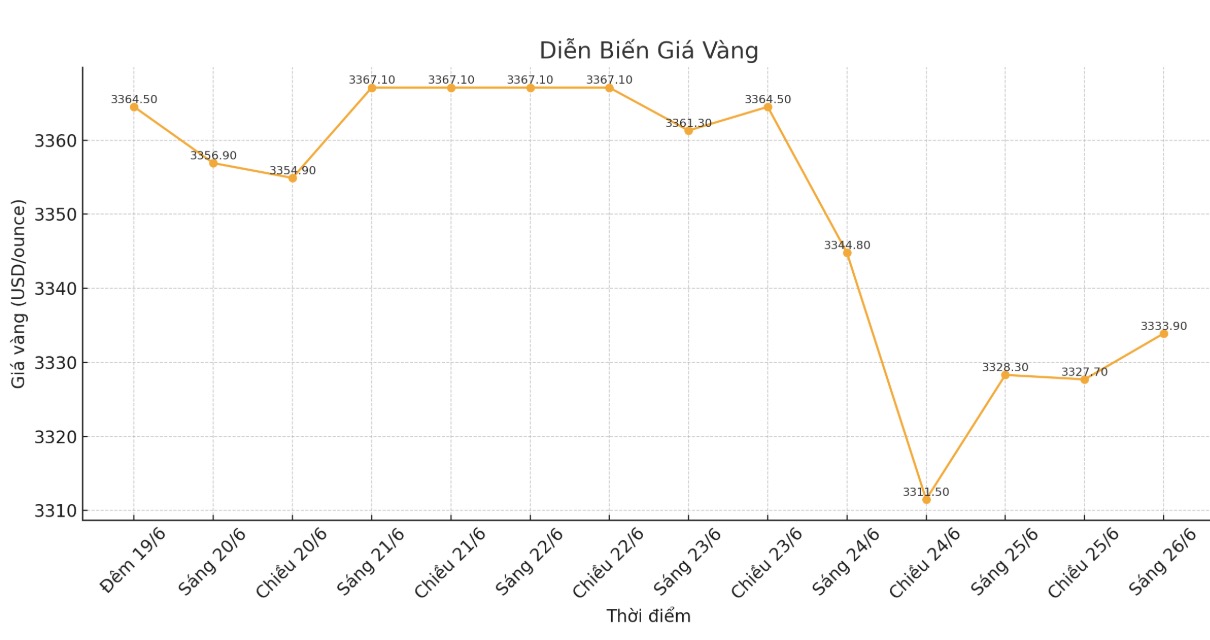The gold market showed solidity as it maintained a slight increase despite significant changes in investor sentiment, from geopolitical risk concerns to expectations for the Fed's monetary policy.
August gold futures closed at $2,347 an ounce, up $8.6 an ounce as of 4:30 p.m. Eastern time. Meanwhile, the Dollar Index fell 0.23% to 97.74.
US stock indexes ended the trading session with mixed developments, reflecting the market's caution in the face of upcoming policy decisions.

The continued signing of the ceasefire between Israel and Iran has significantly reduced safe-haven demand, as both countries continue to commit to the deal, despite clashes near the effective date of the ceasefire.
However, gold prices have not only not decreased but also increased, surpassing the weakening of the USD, showing that buying pressure from institutional and individual investors is still very strong.
The difference between reduced shelter demand and continued purchasing power reflects an important change in market dynamics. Instead of relying on crisis factors, gold investors are shifting to a more proactive strategy, betting on changes in monetary policy.
The focus now is Fed Chairman Jerome Powell's National Assembly hearing, especially his second hearing before the Senate Banking Committee after presenting it to the House Financial Services Committee. From these hearings, investors are shaping expectations for interest rate policy, with the probability of the Fed cutting interest rates at the July meeting currently at 24.8%, according to CME's FedWatch tool.
Mr. Powell's cautious view is creating a complex investment landscape. He stressed the need to fully assess the economic impact of tax policies before deciding to cut interest rates, which is in contradiction to the stronger easing desire from the Donald Trump administration. Several Republican Senators, such as Moreno of Ohio, have questioned the Fed about the political nature of their analytical approach.
Mr. Powell also noted that new tariffs could push up consumer prices and reduce economic activity. However, he also said that this inflationary pressure may be temporary, depending on the actual scope of tax policies.
This stance demonstrates the Fed's commitment to a data-based approach, even as it faces increasing political pressure. Mr. Powell reaffirmed the Fed's dual goals of maximizing employment and stabilizing prices as a basis for the market to maintain expectations, even as many sides pressured for a looser monetary policy.
Recent developments in gold prices show that the market is sensitive to both geopolitical fluctuations and monetary policy signals. After a slight decrease due to the cooling situation in the Middle East, gold prices quickly rebounded thanks to the weakening of the USD and falling Treasury bond yields, showing that basic demand is still very strong.
The fact that gold prices maintain their upward momentum despite no strong safe-haven indicates that investors are betting on a broader economic prospect, where monetary policy and the risk of currency depreciation are decisive factors. This proactive strategy could help gold prices remain more stable than the recent surges caused by the crisis.
In the coming time, the main driving factor for gold prices may no longer be geopolitical tensions but expectations surrounding the Fed's policy and fluctuations in the strength of the USD. The probability of a 24.8% interest rate cut in July will be the foundation for further price fluctuations, and any new signal from the Fed could have a significant impact.
Many investors are betting that the sum of political pressure, economic instability and the Fed's cautious approach will eventually favor loosering policies. This shows that gold continues to serve as a hedge against inflation and the risk of currency devaluation, even as its safe-haven role has somewhat declined.










